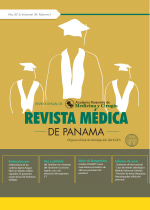Comparación de pruebas moleculares para el diagnóstico de Leishmania spp. en lesiones cutáneas con baja carga parasitaria
Autores/as
DOI:
https://doi.org/10.37980/im.journal.rmdp.20232228Palabras clave:
diagnóstico, Leishmaniasis cutánea, carga parasitaria, PanamáResumen
Introducción: La leishmaniasis cutánea (LC) es un problema grave de salud pública en Panamá. El diagnóstico de esta parasitosis ha sido siempre desafiante, no sólo debido a su similitud con otras infecciones dérmicas, sino también a características particulares de las lesiones, como cargas parasitarias bajas. Materiales y Métodos: En este estudio, se evaluaron mediante cuatro métodos moleculares, 235 muestras de ADN procedentes de lesiones con frotis negativos por LC obtenidas durante el período 2015-2019. Resultados: Los resultados señalan que las sensibilidades encontradas fueron de 75.6% (IC 0.6234-0.8709) para la PCR kDNA-Género específico, de 66.7% (IC 0.5359-0.776) para la PCR Hsp70-Género específico y de 77.6% (IC 0.645-0.8949) para la qPCR 18S ribosomal. Todas las pruebas obtuvieron un valor predictivo positivo de 100%, mientras que el valor predictivo negativo más alto fue con la qPCR (80.58%) y el más bajo con el PCR Hsp70-Género específico (73.2%). En cuanto a la precisión de diagnóstico se obtuvo un rango mayor del 82% en todas las pruebas evaluadas. Conclusión: Este estudio confirma la buena sensibilidad de la PCR kDNA-Viannia para el análisis de lesiones de LC con baja carga parasitaria. Esta metodología es relativamente fácil de estandarizar, por lo que se recomienda su uso en laboratorios clínicos regionales de Panamá. Aun cuando la qPCR 18S ribosomal presentó una sensibilidad relativamente menor, el uso de esta metodología debe ser también considerada por su facilidad de uso, menor tiempo de ejecución y capacidad de cuantificación.
Archivos adicionales
Publicado
Número
Sección
Licencia
Derechos de autor 2023 Infomedic Intl.Derechos autoriales y de reproducibilidad. La Revista Médica de Panama es un ente académico, sin fines de lucro, que forma parte de la Academia Panameña de Medicina y Cirugía. Sus publicaciones son de tipo acceso gratuito de su contenido para uso individual y académico, sin restricción. Los derechos autoriales de cada artículo son retenidos por sus autores. Al Publicar en la Revista, el autor otorga Licencia permanente, exclusiva, e irrevocable a la Sociedad para la edición del manuscrito, y otorga a la empresa editorial, Infomedic International Licencia de uso de distribución, indexación y comercial exclusiva, permanente e irrevocable de su contenido y para la generación de productos y servicios derivados del mismo. En caso que el autor obtenga la licencia CC BY, el artículo y sus derivados son de libre acceso y distribución.






